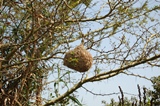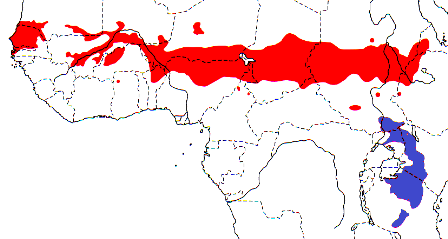Weaver species
Choose different species from drop-down list and press 'Go' button. See Full species list.Speckle-fronted Weaver Sporopipes frontalis
IUCN: Least concern Discovery: 021Categories: cooperative, acacias, Histurgops+Sporopipes,
News items about species
Discovery
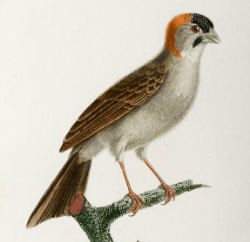
figure from Vieillot 1805 
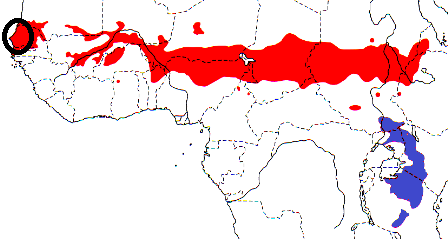
distribution, type locality circled IntroductionThe Speckle-fronted Weaver was formally described by Francois Marie Daudin, a young French zoologist. Daudin wrote Traite elementaire et complet d'Ornithologie (Complete and Elementary Treatise of Ornithology) in 1799-1800, being one of the first modern handbooks of ornithology. Daudin combined Linnean binomial names and good descriptions of the birds. He did not complete his book, as he died before the age of 30.Daudin described the species, based on two individuals in private aviaries in Paris. He noted the origin of the birds as Senegal. The first illustration was provided by Louis Jean Pierre Vieillot, a French ornithologist. Vieillot was interested in living birds, and wrote about the difficulties of keeping Speckle-fronted Weavers in captivity, in addition to a description of the birds. Scientific citationLoxia frontalis Daudin 1800 Traite' d'Orn. 2, p.445 Senegal.Meaning of namesfrontalis (Modern Latin): fronted, browed (L. frons, frontis, the brow, the forehead).First English nameFrontal Grosbeak (Latham 1801).Alternate namesSpeckled Weaver, Scaly-fronted Weaver, Red-fronted Finch.CollectorUnknown.Date collectedBefore 1800.Locality collectedSenegal.Type specimensType specimen not traced (it may be in the Paris museum); the illustration of Vieillot 1805 serves as a type. |
The above is based on Weaver Wednesday 2, a weekly series about the discovery of each weaver species.
This species text first appeared as
Weaver Wednesday [138] - Discovery [21]: Speckle-fronted Weaver on 2015-02-04
1. Basic biology

Identification. The Speckle-fronted Weaver Sporopipes frontalis is one of the smallest weavers. It is finch-like, with a short stubby bill. The head pattern is distinctive (see right) - the black feathers on the crown are tipped white, giving a speckled effect, which gives rise to its name. The nape is chestnut and there is a black moustachial streak surrounding the broad pale grey face. The sexes are alike. The juvenile is like the adult but paler, especially on the nape, which is tawny rather than chestnut. The Chestnut-crowned Sparrow-weaver is much larger and has a chestnut crown and ear-coverts.
Distribution.
Two subspecies of the Speckle-fronted Weaver are recognised (see map below, based on Birds of Africa): Habitat. The Speckle-fronted Weaver inhabits dry bush and open thorn-scrub savanna, and thickets, often around villages. It roosts in groups in old nests throughout the year. When not breeding, it is generally gregarious. Birds allopreen, mainly the head. It moves locally during the rains in Mauritania and is apparently present only during the wet season in the sahel zone of Nigeria. Post-breeding wing moult starts in mid-March, and lasts at least 5-6 months in Nigeria. In occurs in pairs during the breeding season and in flocks of 5-10, sometimes 20, at other times. Food. Food of the Speckle-fronted Weaver consists of seeds, some small insects (picked up on the ground), and termite alates. It feeds mainly on the ground in open gravelly patches, often alongside waxbills. The Speckle-fronted Weaver moves by hopping. Breeding. The Speckle-fronted Weaver is a monogamous, solitary nester, or it may form small colonies. The nest is a large, untidy ball of dry grass with a long entrance tunnel on the side. The nest is lined with finer material and a few grass seed heads, and rarely with feathers. The nest chamber is formed by trampling material. The nest is sited in Ziziphus shrubs, or in branches of acacia trees, 2-6 m above the ground. Nests may be sited near wasp nests. Clutch size is 2-4 eggs, with generally 2 near its northern limits and 3-4 further south. In one record of nest predation, 4 nests in Kenya were raided by a pair of wood-hoopoes which ate several eggs. Active or old nests of the Speckle-fronted Weaver may be taken over for breeding by Red-cheeked Cordon-bleau Uraeginthus bengalus. |
The above is based on Weaver Wednesday, a weekly series about weaver species.
This species text first appeared as
Weaver Wednesday [43]: Speckle-fronted Weaver on 2013-04-10
2. Breeding facts
| Pair bond Monogamous; unclear if long-term pair-bond Breeding season Sept-Dec over much of range, sometimes until Feb/Mar; breeding recorded also Apr-May in Ethiopia, May-Jul in Kenya and May-Aug in Tanzania; in W Africa breeding reported both in wet season and at height of dry season Nest site placed 2-6 m above ground in shrub or tree Nest building n/a Colony size n/a Clutch size 2-4 Egg colour pale grey mottled with darker markings, giving impression of dark brown ground colour Egg size size 17.5 x 12.5 mm (Sudan) Incubation in captivity, incubation by female only, period not recorded Chicks and nestling period chicks fed by both sexes (by regurgitation of crushed seeds) |
Breeding information based on Handbook of the Birds of the World, Vol. 15.
3. Photos of Weaver Nests
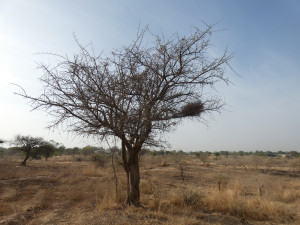 Vm 29549 | 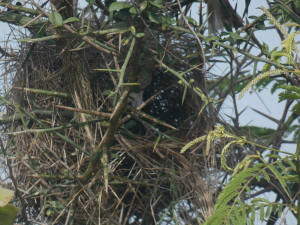 Vm 29544 | 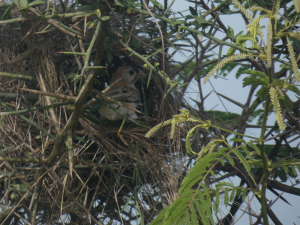 Vm 29543 | 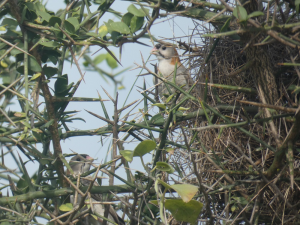 Vm 29542 | 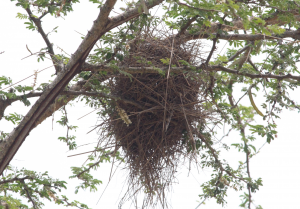 Vm 28594 |  Vm 23018 |
Thumb-nails of most recent PHOWN records - click on one to see its full record
See all PHOWN records for this species here.
PHOWN (Photos of Weaver Nests) provides valuable info on breeding distribution and colony sizes of weavers.
You can contribute by registering and submitting photos at Virtual Museum webpage.
4. Breeding distribution
Google map showing distribution (For species with small ranges you need to zoom in at the correct area to see the range):
yellow blob - range of weaver species; read more about this here.
![]() - PHOWN records with photos
- PHOWN records with photos
![]() - PHOWN records with no photos (Nest Record Cards, other records)
- PHOWN records with no photos (Nest Record Cards, other records)
![]() - Birdpix records
- Birdpix records
![]() - comments on out of range records, or interesting records
- comments on out of range records, or interesting records
![]() - type locality
- type locality
CLICK on the marker on the map to see individual record details.
5. Range changes
Not South African speciesThe above is based on Weaver Wednesday 3, a weekly series about range changes in South African weaver species.
This species text first appeared as
n/a








